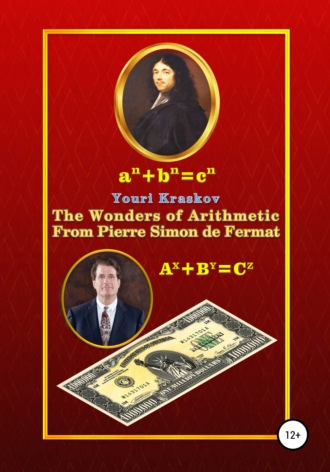
Youri Veniaminovich Kraskov
The Wonders of Arithmetic from Pierre Simon de Fermat
The clarification in this matter begins with the FLT, which states that the sum of two power integer with the same power index greater than the second, cannot be an integer with the same power index. In this sense, this theorem is not at all any puzzle, but one of the basic propositions that unequivocally (!) regulates the addition of integer powers, therefore, it is of fundamental importance for science.26 The fact that the FLT has not yet been proven, indicates only the state of current science, which is falling apart right before our eyes. Science cannot even imagine that if the proof from Fermat himself came to us, it would have been long ago taught in secondary school.
Many people of course, will perceive it as a fairy tale, but only the completely blind ones may not notice that behind all this absurd and awkward history with the FLT, clearly and openly ears of the unholy stick so out, that he was enough to deprive human civilization of access to Fermat's works on arithmetic, so it immediately turned out to be completely disoriented. Instead of developing science they began being vigorously to destroy it and even with very good intentions. But a special zeal in people appears when they have the material stimulus.
Pic. 29. Andrew Beal
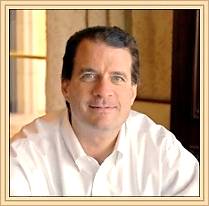
Texas entrepreneur Andrew Beal27 had proposed his conjecture, the proof of which allegedly could lead to a very simple proof of the FLT. Since for the solution of this problem it was proposed first $ 5 thousand, then $ 100 thousand, and from 2013 – a whole million, then naturally it appeared many willing people who began diligently this task to solve. However, in the conditions when arithmetic has long ceased to be the primary basic of all knowledge and still does not know, what is a number, everything turned upside down i.e. one amateur enthusiast was able to set on the ears the whole official science and so, that it had in fact already acknowledged the experience of Baron Munchhausen lifting himself up, taking himself by his collar, wherewith science did not even try at least to conceal its own insolvency (see pt. 4.5).
By working in the intense and tireless search for the FLT proof, it has never even occurred to anyone to search for Fermat’s manuscripts with layouts and calculations, without which he could not do28. However, again from Singh’s book we learn that such an idea came to Euler who asked his friend living in Lausanne (a city not far from Toulouse) to look for at least a little piece of paper with Fermat’s instructions to the FLT proof. But nothing was found, however, they were looking for what we do not really need! It was necessary to look for a cache!!!
Here is the new puzzle, which is not easier! What else kind of cache? … Oh yes! The fact is that only those Fermat's works remained, which he itself had already prepared for publication since otherwise they would hardly have been published. But all the working manuscripts for some reason has disappeared. It looks very strange and it is possible that they can still be kept in the cache, which Fermat has equipped to store the material evidence necessary for him to work as a senator and high-ranking judge. It was quite reasonable to keep calculations and proofs there, since Fermat’s scientific achievements could significantly damage his main work if they were made public before the establishment of the French Academy of Sciences.29
If we could somehow look into this cache, what will we see there? To begin with, let's try to find some simple tasks there. For example, the one that Fermat could offer today for secondary school students:
Divide the number xn−1 by the number x−1, or the number x2n−1 by
the number x±1, or the number x2n+1+1 by the number x+1.
It is obvious that students with the knowledge of solving such a task will be simply a head over the current students who are trained in the methods of determining the divisibility by only some small numbers. But if they else know a couple of the Fermat's theorems, they can easily solve also the more difficult problem:
Find two pairs of squares, each of which adds up to the same number
in the seventh power, for example,
2217=1511140542+539693052=82736654 2+1374874152
Compared to the previous task where calculations are not needed at all, in solving this task, even with a computer calculator you have to tinker with half an hour to achieve a result, while apart from understanding the essence of the problem solution, you need to show a fair amount of patience, perseverance and attention. And who understands the essence of the solution, will be able to find other solutions to this problem.30
Of course, such tasks can cause a real shock to today's students and especially to their parents who will even demand not to “dry the brains” of children. But if children's brains are not filled with elementary knowledge and not trained by solving the corresponding tasks, they will wither by themselves. This is proven by the statistics of the steady decline in today's students IQ compared with their predecessors. Really in fact, the above tasks are only a warm-up for the young generation, but children could produce a real furor for mathematicians offering them some simple Fermat's theorems about magic numbers (see Pt. 4.4.). And this is else a big question, could these theorems being solved by today's professors or will they again need some three hundred years and the story with the FLT will repeat? However, the chances of them in contrast to previous times, are very high because magic numbers are a direct consequence of the same “truly amazing” proof of the FLT, about the existence of which we have direct written evidence from Fermat himself.
Reconstruction of this proof was briefly published as early as 2008 [30], but the unholy was on the alert and presented this event so, that modern science disoriented by the false notion that the problem was solved long ago, has not paid on this any attention. However, all secret sooner or later becomes clear and the decisive word in spite of everything, still remains for science. The question now is only when this science will finally awaken and comes to his senses. The longer it will be in a blissful state of oblivion, the sooner the terrible events will come that already now beginning to shake our world like never before.
In order for science to win a well-deserved victory over the gloom of ignorance and mass disinformation, which are triumphant today, it needs very little. For the beginning it is necessary simply to search for the very cache, in which such secrets of science are hidden, that have not lost their relevance for three and a half centuries.31 Even if the papers found in the cache will be unreadable, the very fact of the existence of the cache will be evidence that science is moving in the right direction and the results will not be long in coming.
We already did something in this direction when we restored the FLT recording in the margins of Diophantus 'Arithmetic' (see pic. 5 and the translation in the end of Pt. 1). Now, by all means, we need to get a complete picture of the whole sequence of events that led to the discovery of the FLT in its final wording published in 1670. It will not be easily at all, but since we got involved in this story, now we have nowhere to retreat and we will strain all our forces to achieve the aim. Fortunately, for this we have all the opportunities granted to us from above to get the coveted access to the cache of the Toulousean senator.
3. What is a Number?
3.1. Definition the Notion of Number
The question about the essence the notion of number at all times was for scientists the thing-in-itself. They of course, understood that they could not distinctly answer this question as well as they could not admit in this since this would have a bad effect on maintaining the prestige of science. What is the problem here? The fact is that in all cases a number must be obtained from other numbers, otherwise it cannot be perceived as a number. To understand for example, the number 365, you need to add three hundred with six tens and five units. It follows that the notion of a number does not decompose into components that are qualitatively different from it and in such a way as usual for science i.e. through analysis, it is not possible to penetrate the secret of its essence.
Scientists having a question about the nature of numbers immediately ran into this problem and came to the conclusion that a general definition the notion of number simply does not exist. But not a such was Pierre Fermat who approached this problem from other side. He asked: “Where does the notion of number come from?” And came to the conclusion that his predecessors were the notions “more”, “less” and “equal” as the comparisons’ results of some properties inherent to different objects [30].
If different objects are compared in some property with the same object then such a notion as a measurement appears, so perhaps is the essence of a number possible revealed through a measurement? However, it is not so. In relation to the measurement, the number is primary i.e. if there are no numbers, there can be no also measurements. Understanding the essence of the number becomes possible only after establishing the number is inextricably connect with the notion of “function”.
But this notion is not difficult to determine:
A function is a given sequence of actions with its arguments.
In turn, actions cannot exist on their own i.e. in the composition of the function in addition to them must include the components, with which these actions are performed. These components are called function arguments. From here follows a general definition the notion of number:
Number is an objective reality existing as a countable quantity, which consists of function arguments and actions between them.
For example, a+b+c=d where a, b, c are arguments, d is a countable quantity or the number value.32
To understand what a gap separates Pierre Fermat from the rest of the science’s world, it is enough to compare this simple definition with the understanding existing in today's science [13, 29]. But understanding clearly presenting in the scientific works of Fermat, allowed him still in those distant times to achieve results that for other scientists were either fraught with extreme difficulties or even unattainable. It may be given also the broader definition the notion of number, namely:
A number is a kind of data represented as a function.
This extended definition the notion of number goes beyond frameworks mathematics; therefore, it can be called as general one and the previous definition as mathematical. In this second definition, it is necessary to clarify the essence the notion of “data”, however, for modern science this question is no less difficult than the question about the essence of the notion a number.33
From the general definition the notion of number follows the truth of the famous Pythagoras' statement that everything existing can be reflected as a number. Indeed, if a number is a special kind of information, this statement very bold at that time, was not only justified, but also confirmed by the modern practice of its use on computers where three well-known methods of representing data are implemented: numerical (or digitized), symbolic (or textual) and analog (images, sound, and video). All three methods exist simultaneously.
Pic. 30. Pythagoras
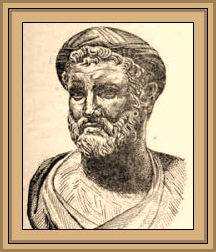
A strikingly bold statement even for our time that thinking is an unconscious process of computations, have been expressed in the 17th century by Gottfried Leibniz. Here, thinking is obviously understood as the process of data processing, which in all cases can be represented as numbers. Then it is clear how computations appear, but understanding of the essence of this process in modern science is so far lacking.34
Pic. 31. Gottfried Leibniz
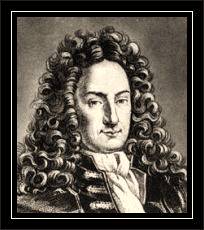
All definitions of a number have one common basis:
Numbers exist objectively in the sense that they are present in the laws of the world around us, which can be known only through numbers.
From the school bench everyone will learn about numbers from the childish counting: one, two, three, four, five etc. Only the Lord knows where did this counting come from. However, there were attempts to explain its origin using axioms, but the origin of them is as incomprehensible as the counting. Rather, it looks like a certain imitation of the Euclid's "Elements" to add to knowledge the image of science and the appearance of solidity and fundamentality.
The situation is completely different when there is a mathematical definition the essence of a number. Then for a more complete understanding of it, both axioms and a countable quantity become a necessity. Indeed, this definition to the essence of a number includes arguments, actions and a countable quantity. But arguments are also numbers and they should be presented not specifically each of them, but by default i.e. in the form of a generally accepted and unchanged function, which is called the number system, however it no way could to appear without such a notion as a count. Now, axioms turn out to be very appositely and without them a count may be got only from aliens. In reality it was namely so happened since such sources of knowledge as the Euclid's “Elements” or the Diophantus' “Arithmetic” were clearly created not by our, but by a completely different civilization.35
If axioms regulate the count, then they are primary in relation to it. However, there is no need to determine their essence through the introduction of new notions because the meaning of any axioms is precisely in their primacy i.e., they are always essentially the boundaries of knowledge. Thus, axioms receive an even more fundamental status, than until now when they were limited only to the foundation of any separate system. In particular, the system of axioms, developed by the Italian mathematician Giuseppe Peano, very closely correspond to the solution of the problem for constructing a counting system although this main purpose was not explained apparently with a hint on justification the essence the notion of number. The scientific community perceived them only as a kind of “formalization of arithmetic” completely not noticing that these axioms in no way reflect the essence of numbers, but only create the basis for their presentation by default i.e. through a count.
If the main content of axioms is to determine the boundaries of knowledge related to generally accepted methods of representing of numbers, then they should be built both from the definition the essence of the notion of number and in order to ensure the strength and stability of the whole science's building. Until now, due to the lack of such an understanding of the ways of building the foundations of knowledge, the question about the essence of numbers has never even been asked, but only complicated and confused.
Pic. 32. Giuseppe Peano
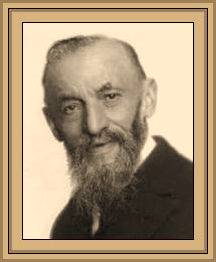
However, now when it becomes clearer and without any special difficulties, all science can receive a new and very powerful impetus for its development. And then namely on such a solid basis, science acquires the ability to overcome with an incredible ease such complex obstacles, which in the old days, when there was no understanding the essence of numbers, they seemed to science as completely impregnable fortresses36.
3.2. Axioms of Arithmetic
3.2.1. Axioms of a Count
This path was first paved at the end of the 19th century by Peano axioms.37 We will make changes to them based on our understanding the essence of the number.
Axiom 1. A number is natural if it is added of units.38
Axiom 2. The unit is the initial natural number.
Axiom 3. All natural numbers form an infinite row, in which each
following number is formed by adding unit to the previous number.
Axiom 4. The unit does not follow any natural number.
Axiom 5. If some proposition is proven for unit (the beginning of
induction) and if from the assumption that it is true for a natural
number N, it follows that it is also true for a natural number
following N (induction hypothesis), then this sentence will be true
for all natural numbers.
Axiom 6. In addition to natural numbers, there can exist another
numbers derived from them, but only in the case if they possess all
without exception the basic properties of natural numbers.
The first axiom is a direct consequence from definition the essence of number, so Peano simply could not have it. Now this first axiom conveys the meaning of defining the notion of number to all another axiom. The second, fourth, and fifth axioms are preserved as in Peano version almost unchanged, but the fourth axiom of Peano is completely removed from this new system as redundant.
The second axiom has the same meaning as the first one in the Peano list, but is being specified in order to become a consequence of the new first axiom.
The third axiom is the new wording of Peano's second axiom. The notion of the natural row is given here more simply than by Peano where you need to guess about it through the notion of the “next” number. The fourth axiom is exactly the same as the third axiom of Peano.
The fifth axiom is the same as by Peano, which is considered the main result of the entire system. In fact, this axiom is the formulation the method of induction, which is very valuable for science and in this case allows to justify and build a count system. However, a count is present in one or another form not only in natural numbers, but also in any other numbers, therefore one more final axiom is needed.
The sixth axiom extends the basic properties of natural numbers to any numbers derived from them because if it turns out that any quantities obtained by calculations from natural numbers, contradict their basic properties, then these quantities cannot belong to the category of numbers.
Now arithmetic gets all the prerequisites in order to have the status the most fundamental of all scientific disciplines. From the point of view the essence of a count everything becomes much simpler and more understandable than until now. On the basis of this updated system of axioms there is no need to “create” natural numbers one after another and then “prove” the action of addition and multiplication for the initial numbers. Now it’s enough just to give names to these initial numbers within the framework of the generally accepted number system.
If this system is decimal, then the symbols from 0 to 9 should receive the status of the initial numbers composed of units in particular: the number “one” is denoted as 1=1, the number “two” is denoted as 2=1+1, the number “ three ” as 3=1+1+1 etc. up to the number nine. Numbers after 9 and up to 99 adding up from tens and ones for example, 23=(10+10)+(1+1+1) and get the corresponding names: ten, eleven, twelve … ninety-nine. Numbers after 99 are made up of hundreds, tens and units, etc. Thus, the names of only the initial numbers must be preliminarily counted from units. All other numbers are named so that their quantity can be counted using only the initial numbers.39
3.2.2. Axioms of Actions
All arithmetic actions are components of the definition the essence of the number. In a compact form they are presented as follows:
1. Addition: n=(1+1…)+(1+1+1…)=(1+1+1+1+1…)
2. Multiplication: a+a+a+…+a=a×b=c
3. Exponentiation: a×a×a×…×a=ab=c
4. Subtraction: a+b=c → b=c−a
5. Division: a×b=c → b=c:a
6. Logarithm: ab=c → b=logac
Hence, necessary definitions can be formulated in the form of axioms.
Axiom 1. The action of adding several numbers (summands) is their
association into one number (sum).
Axiom 2. All arithmetic actions are either addition or derived from
addition.
Axiom 3. There are direct and inverse arithmetic actions.
Axiom 4. Direct actions are varieties of addition. Besides the addition
itself, to them also relate multiplication and exponentiation.
Axiom 5. Inverse actions are the calculation of function arguments.
These include subtraction, division and logarithm.
Axiom 6. There aren’t any other actions with numbers except for
combinations of six arithmetic actions.40


